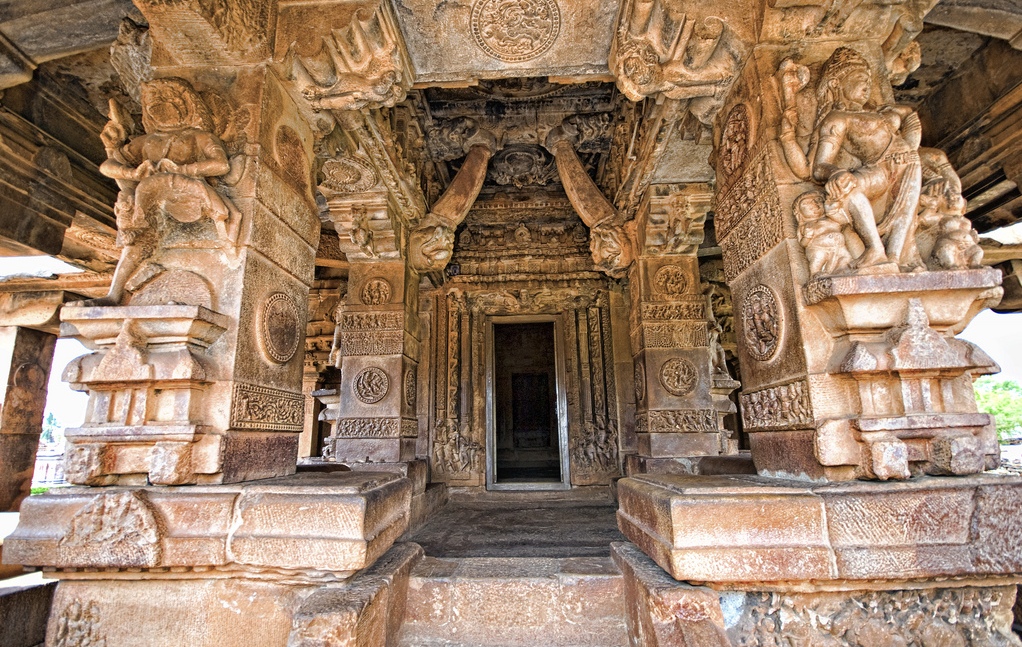
The central idea behind the formation of Hindu temples was to give a structure to people’s religious beliefs, and create a link between ordinary men and God. Temples symbolize enlightenment and knowledge, both essential components for achieving liberation from the vicious cycle of death and rebirth, as explained by the Hindu philosophy. There are limited resources to know about the earliest temples constructed in India. However, such construction activities were usually carried out under royal patronage. This is mainly because temple building was, and continues to be, an expensive and labor-intensive task, which could have been undertaken only by someone with authority and influence over others. These temples were, thus, also built to keep the rulers’ remembered for countless generations to come. Having said that, they also fulfilled a variety of purposes for the ordinary people. The temple complex usually included community resources such as schools and reservoirs. Thus, most people contributed to its development, either in terms of donations or labor. Additionally, the spacious halls attached to the temples also provided space for gatherings and celebrations. Music, dance and recitation of folklores were common events in the temple premises. The temples, therefore, went beyond just being architectural marvels. These were centers for social, political and economic activities.
The latter half of the 7th century saw a drastic change in the structure of Hindu temples, as they gradually started exhibiting a definite form. Today, the common structural elements of temples include the garbhagriha, vimana, mandapa and pradakshina patha, to name a few. The garbhagriha, literally the womb-house, is the innermost sanctum with a single entrance, wherein the main deity is placed. This exclusive chamber is usually the place for performing rituals by the priests. The pillared hall in front of the garbhagriha houses a large number of worshippers, and is known as the Mandapa. The mountain-like spire, which is wither curved or pyramidal, is known as the shikhara in North India and vimana in South India. The path surrounding the garbhagriha is known as the Pradakshina Patha. The ritual of walking in a clockwise direction around the deity is considered to be a symbol of respect for the God or Goddess. Other structures include ardhamandapa or main entrance, pitha or platform of the temple, and gopurams or ornate towers. Gopurams not only act as lightning arrestors, but also give an approximate indication of the distance between pilgrims and the temple. Although the elements of Indian temples differ across regions, the essence lies in the single philosophy of design that forms their basis.

The styles of Indian temples can be broadly divided into three, namely, Nagara, Dravida and Vesara. The nagara style is popularly observed in North India. The temples of this kind are usually built on a stone platform and can have more than one shikhara. The garbhagriha in such temples is always located right underneath the tallest tower. The best examples of the north Indian style of temple architecture are the Khajuraho Group of temples, Sun temple, Konark, Surya temple, Modhera, Gujarat and Ossian temple, Ossian, Gujarat. On the other hand, the Dravida temple, found in South India, is enclosed within a compound wall. Subsidiary shrines and temple tanks are usually found within the complex. Additionally, the walls of these temples are much more elaborate as compared to those in the Nagara style. Gopuram is also a distinguishing element of these temples. The finest examples of Dravidian style are temples of Tanjore, Madurai, Mahabalipuram, Badami, Pattadakal and Kanchipuram. Yet another distinct style emerged from the hybridization of the Nagara and Dravida architectural styles in the mid-17th century, called the Vesara. It is believed to be developed under the patronage of the Chalukya rulers in Karnataka.
In terms of the construction, the Indian temples were built with a variety of materials, depending upon its availability in the region. While the early structures were made using less durable materials like timber, brick, bamboo and plaster, the relatively contemporary ones made use of different stones, along with novel techniques. This is essentially why remains of the earliest temples are almost negligible.
As per ancient Hindu scriptures, the temple is viewed as a link between the physical world and the abode of the divine. To bridge the gap between the two, the concept of Vastupurushamandala was introduced. The term Vastupurushamandala has been derived from three separate words, namely, vastu or physical environment, purusha or energy, and mandala or diagram. The human body, a microcosm, has been equated with the idea of the square shape, which is considered to be the most primary geometric form for various reasons. Firstly, the four sides of the square represent the four cardinal directions. Secondly, it has the capacity to encompass and give rise to other integral shapes such as triangle, hexagon and the like. Thirdly, square represents order, unity and a complete cycle, starting and ending at the same point. Finally, according to Hinduism, humans’ way of living is governed by the number four itself – four seasons, four Vedas, four heads of Brahma, four phases of life, and four great eras. A similar amount of importance is also given to circle, which forms the basis of mandalas, along with symbolizing immortality and timelessness. In terms of the Vastupurushamandala, a large square is divided into smaller squares, making a grid-like pattern with each square unit clearly marking the areas of respective gods and thus, their unique universes.

After drawing a perfectly measured sketch of the Vastupurushamandala, it is outlined on the site of temple construction. This is done to seize all the cosmic and divinely energy underneath the temple. The symmetrical shape with all sides and angles equal maintain the force towards the centre, thus, creating equilibrium. It is believed that the larger the total number of squares, the more positive energy is held and eventually emitted to the physical world. The central point of the square is where the garbhagriha is built as the heavenly place for the main icon. A number of temples in South India, such as the Chenna Kesava Temple in Belur, is based on the stellate pattern. This means that the garbhagriha is created in an elaborate star shaped-pattern, entirely based on the complex configuration of squares.
The other temple activities or rituals also hold immense value, especially in terms of activating the five senses. For instance, offering flowers is associated with olfaction, while sounding the conch shell is associated with the hearing sense. After the activation of the five bodily senses, parikrama, that is, walking around the garbhagriha, is meant for absorbing all the positive vibrations. Additionally, ringing the temple bells produces a distinct sound, which is believed to create unity in both the hemispheres of the brain. Even the practice of idol worship aims at aiding the process of focusing one’s attention on the mind. Similarly, applying kumkuma or tilak on one’s forehead is also based on the ancient Hindu scriptures. The sixth chakra or the third eye is centered around the forehead, and is believed to be the most receptive area.
Vastu Shastras, the Hindu texts on architecture, describe principles with great precision and scientific backing. This is essentially why making use of these fundamental basics, such as design, layout, measurements, ground preparation and space arrangement, at every stage of construction is beneficial. Hindu temple architecture has developed over thousands of years following these principles and has richly blossomed into centres of Hindu beliefs and pilgrimages. The architectural styles of the temples are now completely engrained in the psyche of the people and any major tinkering with these styles is hard to think of.
Supriya is currently pursuing a Bachelors degree in Psychology from Lady Shri Ram College for Women. A self confessed bibliophile, books are her constant source of solace. She finds it liberating to express her ideas through various forms of art.


